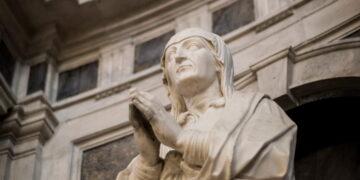Contents
Questo articolo è disponibile anche in:
It is now since February 24th 2022 that the breadbasket of Europe, Ukraine, has become the center of gravity of every newscast following the widening of the conflict between Kiev and Russian and pro-Russian forces that had started already in 2014. Sadly, only a war could put the continent’s second-largest country in the spotlight. Previously, it was neglected and unfairly ignored in Western European debates. In Italy, the situation was not at all dissimilar.
Ukraine evoked only faded ideas in the mind of the average Italian who knew this nation primarily through hard-working men and comely women. Yet the historic gifts of ingenuity and skill that have characterized our people enabled us to establish deep ties even with this distant eastern area of Europe. It was through Odesa that the southern territories of the Russian Empire ended up admiring Italian art and culture.
Odesa: an imperial crossroad
Odesa is not an ancient city, however much of its territory has been a crossroad of peoples and exchanges of all kinds for millennia. Through here the Scythians, Greeks, Romans, Huns, Avars, and Bulgarians passed by. The area became subject to the Grand Duchy of Lithuania in the 14th century following the victory over the Tatars by Grand Duke Algirdas at the Battle of Blue Waters in 1362.
The Genoese used the future Odesite coastline as an anchorage for their ships between the 13th and 14th centuries, in the light of the presence in Crimea and the Sea of Azov of several of their fortresses that were created to provide security for trade. It can be said that Italians were already present here way before the founding of the city. It was not until 1794, however, that Catherine the Great of Russia decided to give this ancient, though unurbanized crossroads, an urban and imperial significance.

The area had recently been taken from the Ottoman Empire in 1774. This victory had enabled the Russians to conquer much of the northern Black Sea coast. These military successes had been possible thanks to the leadership of famous commander Grigory Aleksandrovič Potëmkin, who also assumed the role of city founder.
In fact, he ordered the construction of many Russian cities in accordance with Catherine such as Cherson, Sevastopol, Simferopol, and Nikolayev (now known as Mykolayiv), now at the center of the clash between Russia and Ukraine. The flagship of Potëmkin’s founding work would be Odesa itself, which he began to design. However, fate decided otherwise, causing him to pass away in 1791.
It was therefore necessary to use other men for the deed. The actual founders of the new city were a Neapolitan nobleman and two French noblemen: General de Ribas, Count Langeron, and the Duke of Richelieu. Odesa was thus already in its essence a cosmopolitan center. With Catherine’s death in 1796, the building push was resumed by Tsar Alexander I. The task of granting the city an imperial dignity fell to an Italian architect, Francesco Boffo.

He strived in the design of buildings and monuments for more than four decades. The Potëmkin Stairs are one of the main examples of his profuse work. The use of Italian masters was by no means new to the lands of the tsars. Capital city Saint Petersburg itself was magnified by various Italian architects in the 18th century, just as the Moscow Kremlin was also extensively embellished by architects from Bel Paese since the 15th century. The dream of creating a thriving, modern Russian metropolis on a warm sea could finally take place.
City’s swift expansion
It did not take long before the Russian expansionist force allowed Odesa to grow at a Californian pace. In 1802 it included only 9,000 inhabitants, in 1860 it already numbered 120,000, and in 1914, on the eve of World War I, the population was as high as 670,000.
Growth had not been without difficulties. In 1833 a severe famine hit the city, and in 1854 a French-English naval squadron had bombarded the city due to the Crimean War. All this could not, however, curb the feverish Odessite growth that was nourished on the one hand by the atavistic Russian need for a safe outlet to a warm sea and on the other hand by the young soul of the city that attracted individuals from all backgrounds.
By the early 20th century, it was the fourth largest city in the empire after Saint Petersburg, Moscow and Warsaw. The rapid development also led to the establishment of several cultural centers. In 1817, the Richelieu High School was founded, second only to the one in Carskoe Selo. About 600 new texts were published each year. The city theater welcomed companies from all over Europe, amongst which Italian companies were the most popular.
In 1886, the first bacteriological station was opened, and in 1908 it was first aeroclub’s turn whose star was Odesite aviator Utochkin, Russia’s second-ever airplane pilot. The city demographics were extremely diverse and embodied the vast pluralism of the largest empire on the planet.
Each major community had its own dedicated street as revealed by toponymy. Albanians Street, Jews, Greeks, Genoese, Bulgarians, Poles, Serbs, Moldavians. Italians were given both a street and a boulevard. This was not by chance given the foundation and the construction of new buildings were largely thankst to the work of Italians. The original population nucleus of the city in the early 19th century had as many as 10 percent of its inhabitants originally from the Boot.
An almost Mediterranean sunshine
Right in Odesa in 1898 the most famous Neapolitan song was written: ‘O sole mio. It seems that the composition of the work was inspired by a wonderful sunrise over the Black Sea that brought to mind the radiant Mediterranean sun. And it is precisely the sun that played an important role in the city’s fascination with the inhabitants of all Russia.
As Odesite Jewish writer Isaak Babel’ pointed out, Odesa would give Russian literature something it had always lacked: Sun. Babel pointed out that the cold, dreary plains of Russia had heavily influenced Russia’s greatest writers; therefore, it would be the southern sunshine that would generate a new great writer who would surpass Dostoevsky’s “Karamazov’s gray pavement” and Turgenev’s “dewy morning.”
Not surprisingly, the environment surrounding a people can greatly influence certain aspects of the human soul. For example, an inland farmer is generally less inclined to the frenetic desire for discovery and sociability that a chaotic, bustling seaside city can easily offer. The countryside elicits reflection, inwardness, serenity and granitic stability. The sea spurs vitality, uncertainty, rapidity and multilaterality.
Odesa seemed a breaking point of the purely agricultural and “winter” societies of Ukraine and Russia. An island in a sea of plains. The great multitude of diverse and often mutually hostile peoples, combined with the sea breeze and the constant coming and going of merchants and seafarers brough about the appearance of features typically linked to large Mediterranean centers.
Cultural effervescence could have a both courtly and popularly outlet. Babel tells us about two cultural centers: the Literaturka (a circle of “real artists, real journalists, perfumed young ladies, fat bourgeois“) and the “Family Circle of Stage Workers” within which more modest people spent their evenings conversing on a wide variety of topics. The second was a favorite of the Jewish scholar as the atmosphere was more authentic and theater-like.
In Odesa, it was also possible to cultivate another Mediterranean attribute, at which the Neapolitans are masters, namely the art of making do. Babel speaks of “air men” (from Yiddish “luftmentsh“) who were those Jews who engaged in unspecified activities to make ends meet. The Odessa Jewish community, of which we have a vivid description from the inside thanks to the writer’s “Tales of Odesa,” was one of the most active on the city scene.
The Pearl of the Black Sea was seen as a promised land by Jews who could go about their business here. Socially, the situation was more tolerable, too as pogroms were less frequent here than elsewhere. However, the pervasive Jewish presence in the city’s economic body caused strong discontent.
For example, in the early 1900s the grain trade was by 90% in the hands of Jewish merchants, and the entire community accounted for about 30 percent of the city body by then. Odesa’s cultural exceptionalism vanished firstly with the Russian Civil War and then with the harsh Stalinist repressions.

The thriving Italian community was wiped out following the Bolshevik victory in the Civil War. Prior to 1917, Italians ran maestrances, restaurants, cafeterias, theater companies, and hotels. Also, the Dante Alighieri Society was present in the city which served as a sounding board for the spread of the Italian language and culture throughout the Russian Empire.
This strong bond was artificially and violently severed by the new communist ideology, which labeled it all as “bourgeois activities” to be eliminated. The few Italians who did not leave Odesa decided to live under the radar during the Soviet era out of fear of reprisals. This was also the sad fate of many other historic minorities who found themselves forced to flee or to be forcefully assimilated.
The Jewish community continued to grow and prosper until 1941, year of fateful Operation Barbarossa. German expropriation and violence also found fertile ground among the city’s Slavic elements, who had grown weary from decades of economic harassment perpetrated by many Jewish merchants. The cosmopolitan Odesite fascination had by then been made a distant memory by that new socialist state that ironically advocated brotherhood among peoples.
Odesa was now ready to play the role of an important, albeit much more anonymous, Soviet city. What remains of that city today? Perhaps very little except for the center with its monuments that was once enlivened by voices of Italians, Greeks, Russians, Ukrainians, Jews, Moldavians, Albanians. War has recently knocked again at the gates of the Black Sea’s city, this time between those two Slavic peoples whose differences were in the past faintly recognizable. Then again, the magic of exceptionalism is always feeble and in danger. If not, we would be talking about simple normality.





















